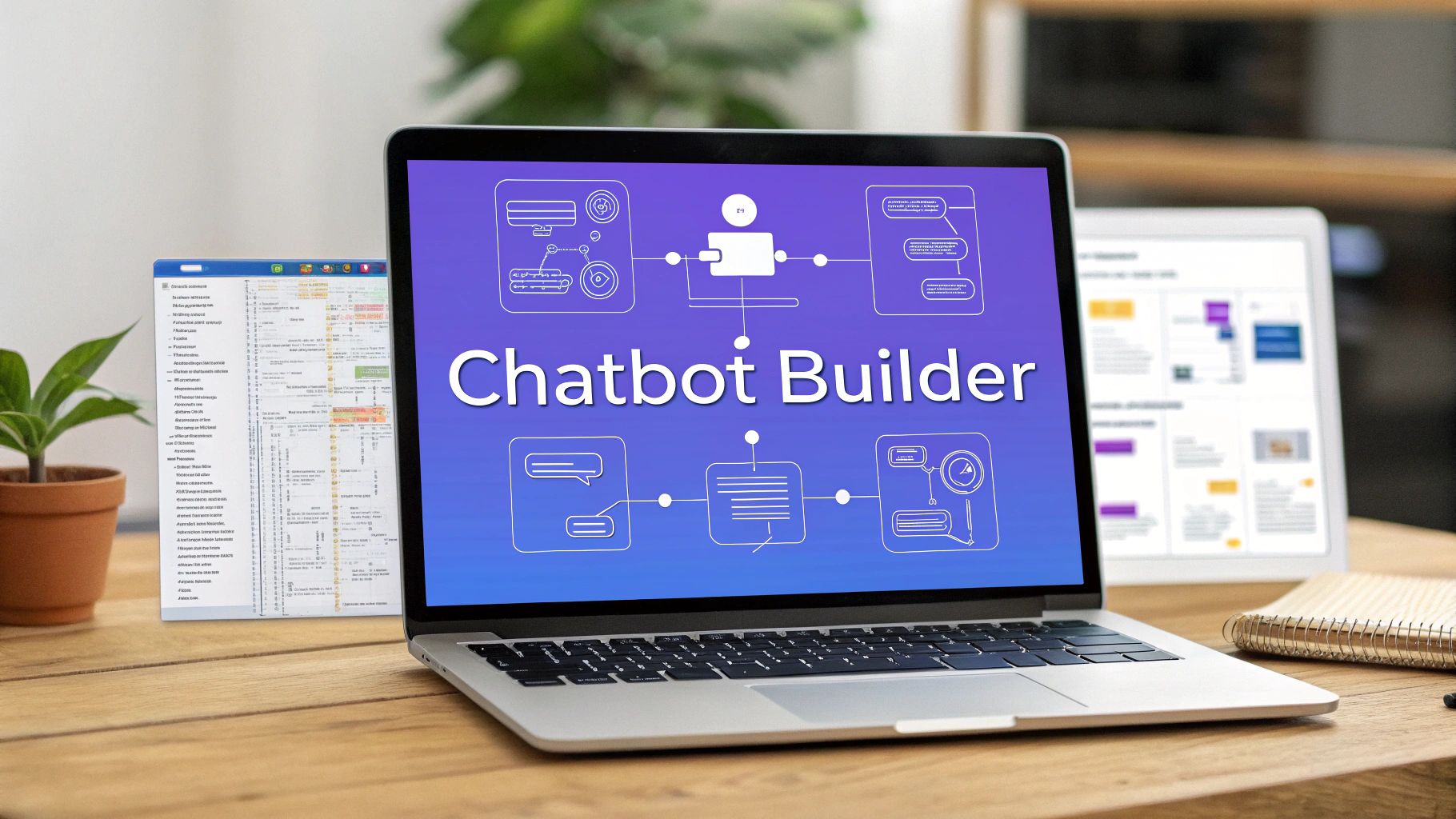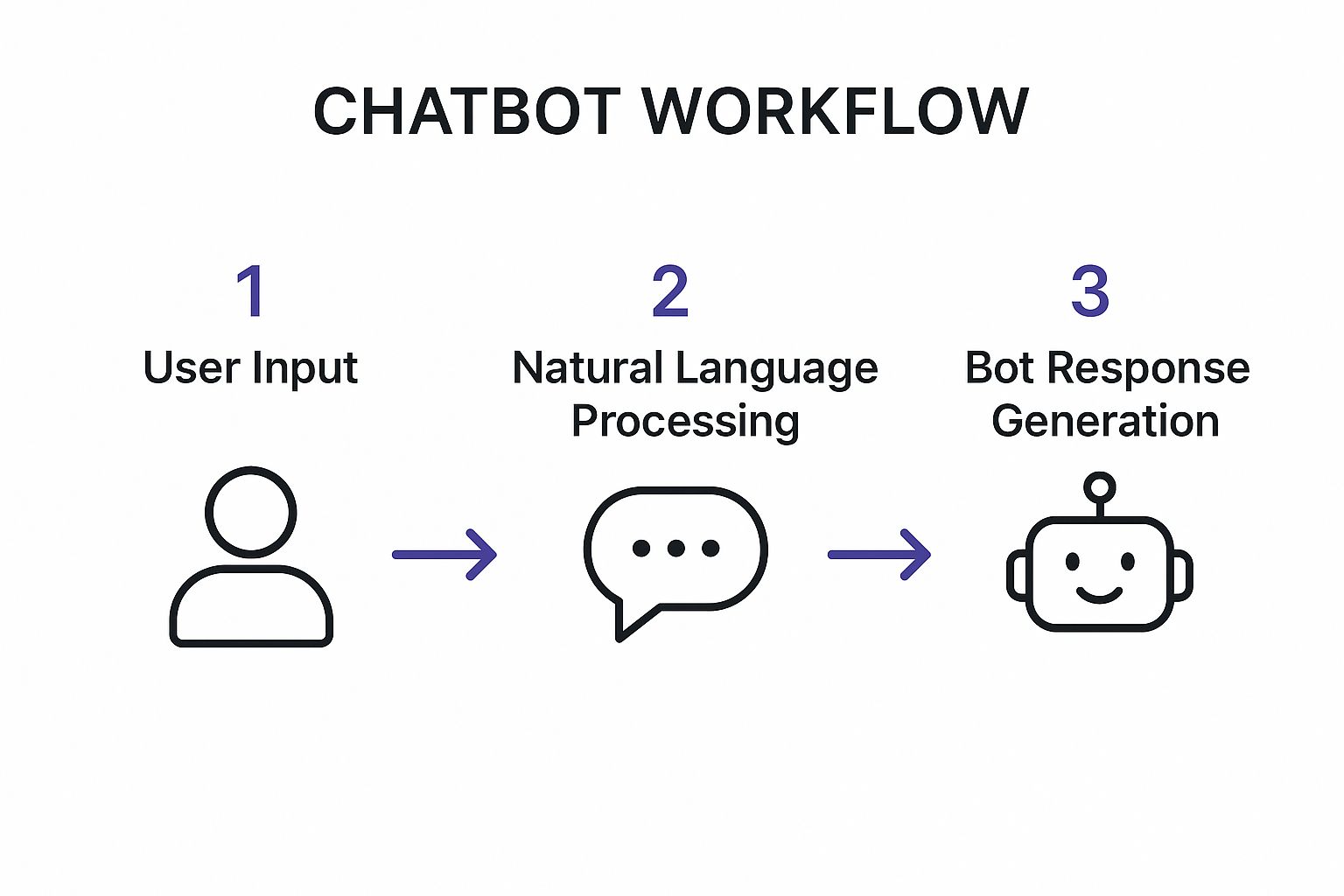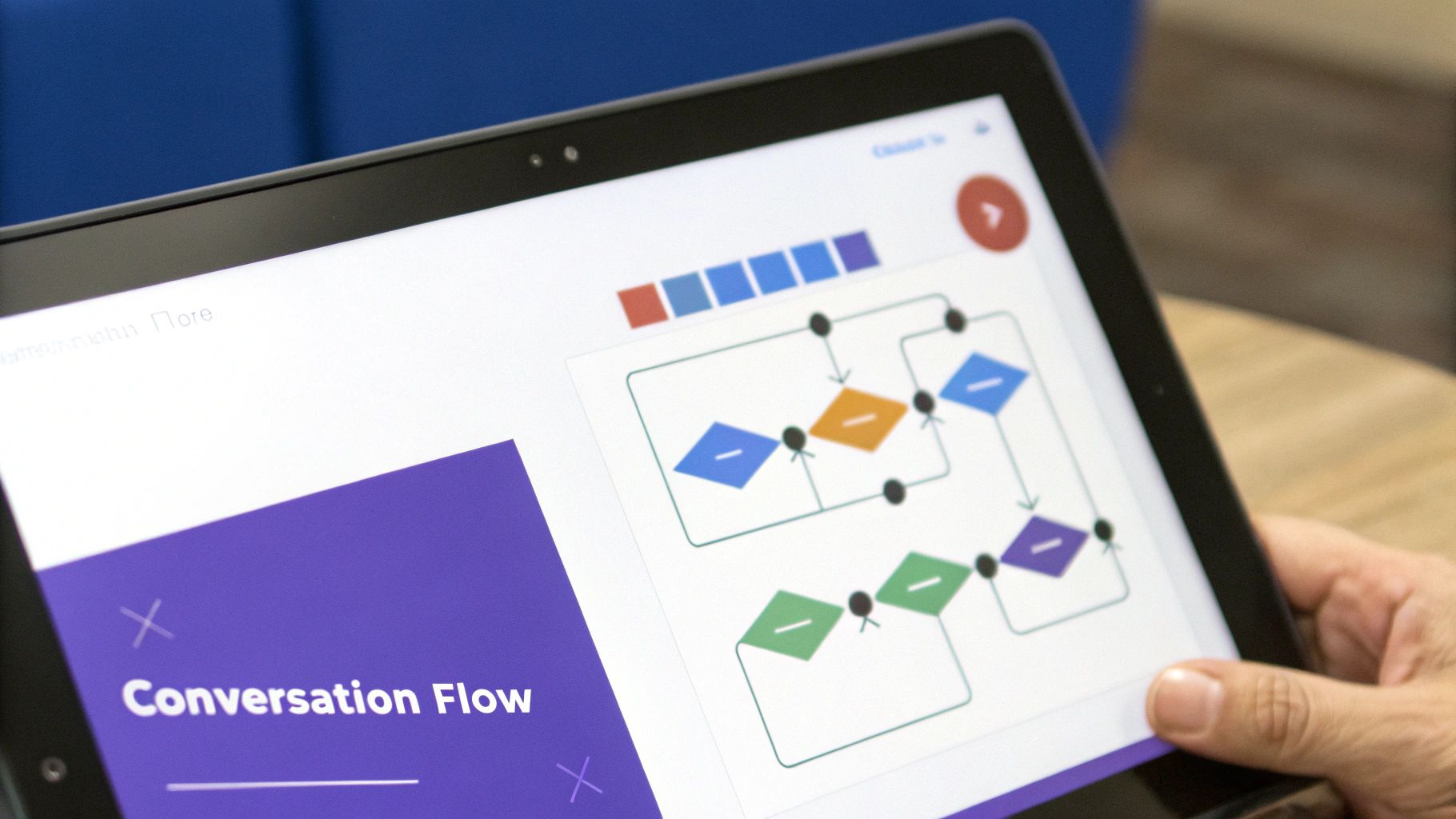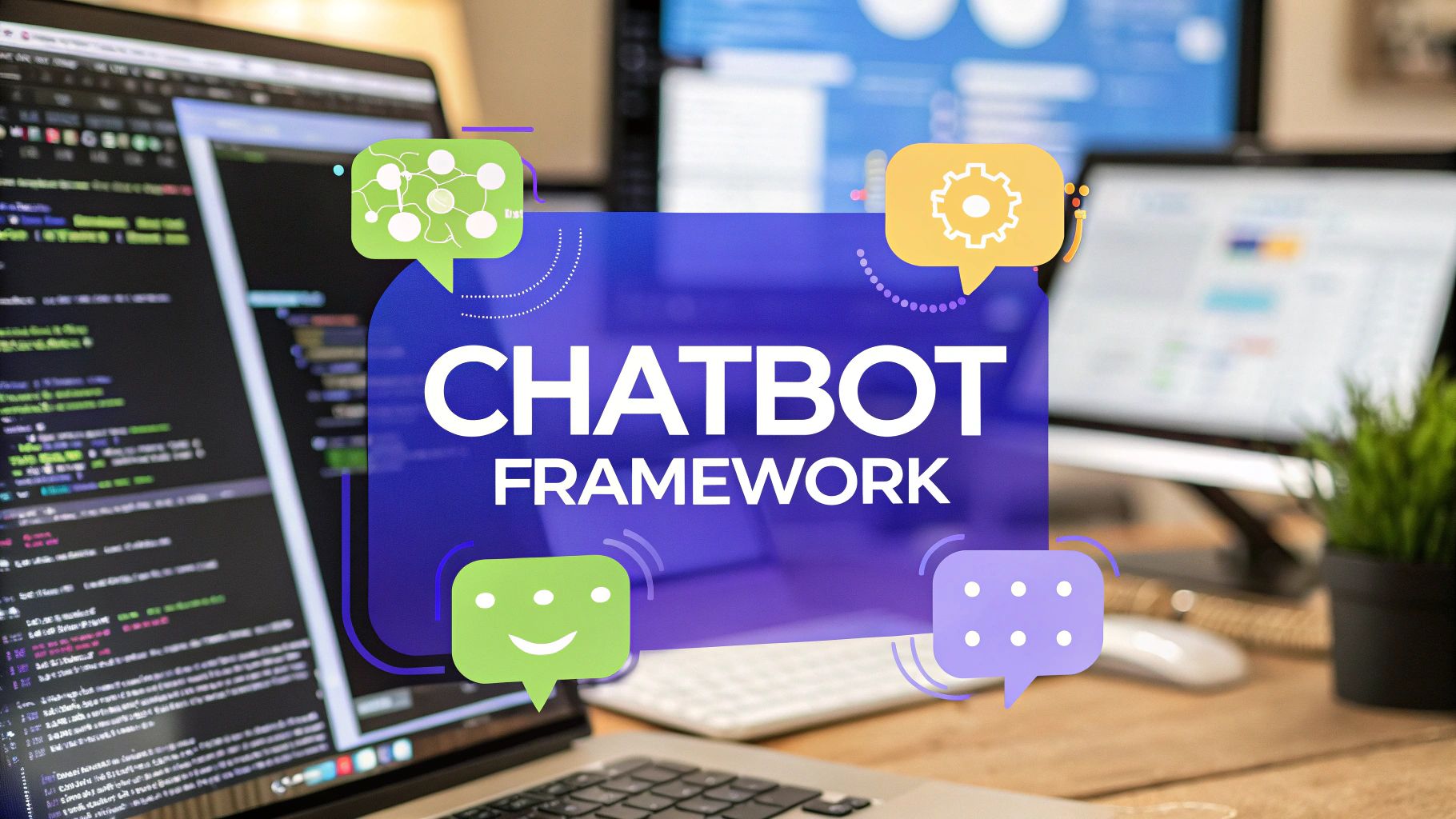How to Build a Chat Bot That Works Effectively
Learn how to build a chat bot with proven strategies. This guide covers planning, training, and optimization to ensure real results.

Building a chatbot really just breaks down into a handful of core stages: figuring out its purpose, picking a platform like Chatiant, designing the conversation, training it with good data, and finally, getting it in front of users. Think of it less as a complex technical project and more like a clear roadmap that any business can follow.
Your Chatbot Building Quickstart Guide
The idea of creating a chatbot can feel pretty intimidating, but the process is far more strategic than it is technical. Before you ever write a line of code or even sign up for a tool, the most important thing you can do is define what you actually want the bot to accomplish.
Is its main job to generate sales leads? Or is it meant to provide 24/7 customer support by fielding common questions? Maybe you need it to automate internal tasks for your operations team. Getting this answer nailed down first makes every other decision easier and more effective.
Once you have that strategic clarity, the technical side starts to fall into place. With a clear purpose, you can pick the right platform—a no-code solution like Chatiant is a fantastic choice for businesses that want to build and launch fast without a dedicated dev team. From there, you'll map out the conversational paths a user might take, making sure the interaction feels natural and genuinely helpful. We walk through the whole thing in our detailed guide on how to build a chatbot that works.
The Core Development Stages
The entire build process, from high-level strategy to hands-on deployment, can be broken down into a few key phases. Each one builds on the last, creating a structured and manageable workflow that keeps your project on track.
To give you a clearer picture, here’s a quick overview of what you can expect at each step.
Core Chatbot Development Stages
This systematic approach ensures you move from a big idea to a functional, value-adding tool without getting lost along the way.
Once your bot is live, it follows a fundamental interaction flow, using its training to interpret user input and generate the right response.

As the infographic shows, Natural Language Processing (NLP) is the "brain" of the operation. It figures out what the user means, not just what they typed, before the bot formulates an answer. It’s this kind of sophisticated-yet-accessible tech that has fueled explosive growth in the market. The global chatbot industry leaped from $2.47 billion in 2021 to a projected $15.57 billion by 2025. It’s even expected to surpass $46 billion by 2029.
Laying the Groundwork for a Smart Bot

A great chatbot starts with a solid plan, not with a single line of code. I've seen it time and time again: teams get excited and rush straight into the build, only to end up with a bot that doesn't actually solve a real problem. This foundational phase is where you define not just what your bot does, but why it exists in the first place.
The first, most critical question you need to answer is: what specific user problem will this bot solve? This one question will steer every single decision you make from here on out. Are you trying to capture more sales leads after hours? Provide instant answers to common questions? Or maybe automate repetitive tasks for your own team? Each goal demands a completely different approach.
Think about it. A lead generation bot for a real estate agency needs to be proactive and engaging, asking qualifying questions about a buyer's budget and preferred location. On the other hand, an internal IT support bot should be direct and efficient, helping employees reset a password or file a support ticket as quickly as possible. Without this clarity, you risk building a generic tool that isn't particularly good at anything.
Define Your Bot's Core Function
Before you map out a single conversation, you have to pinpoint the bot's exact job-to-be-done. I like to think of it as writing a job description for a new digital employee. This little exercise forces you to give the bot a focused purpose so it doesn't suffer from trying to be a jack-of-all-trades.
Here are some common chatbot functions to get you started:
- Customer Support: Answering the usual questions about order status, return policies, or service features. This is a huge win for freeing up human agents to handle more complex issues.
- Lead Generation: Engaging website visitors, asking qualifying questions, and booking demos or consultations, often when your sales team is offline.
- E-commerce Assistant: Helping shoppers find products, offering smart recommendations, and guiding them smoothly through the checkout process.
- Internal Automation: Assisting your own employees with HR policies, IT troubleshooting, or booking meeting rooms.
Choosing one primary function will make the entire process of how to build a chat bot far more manageable and, ultimately, more successful.
Crafting a Persona and Voice
Once you know your bot's purpose, it's time to give it some personality. How your bot communicates is just as important as what it says. This "voice" needs to align with your brand's identity and connect with your target audience.
A bot's persona isn't just a fun gimmick; it's a critical part of the user experience. A consistent and appropriate tone makes interactions feel more natural and less robotic, which directly impacts user trust and engagement.
Should it be formal and professional, or more friendly and conversational? A bot for a law firm, for instance, should project authority and trustworthiness. But a bot for an online gaming community can be more playful and even use a bit of slang. Documenting these voice and tone guidelines ensures everyone building the bot's responses is on the same page.
This is all made possible by huge strides in artificial intelligence and natural language processing, which allow bots to mimic human conversations with surprising accuracy. The chatbot ecosystem is evolving quickly, built on these AI advancements that let businesses offer immediate, interactive engagement. For a deeper dive, you can explore a detailed analysis of the chatbot market to understand these technological drivers.
Building and Training Your Bot in Chatiant

With a solid plan in hand, it's time to roll up your sleeves and bring your chatbot to life. This is where the strategy becomes a reality, and thankfully, platforms like Chatiant make it possible for anyone to do this, no coding required. The goal here is to create a digital "brain" for your bot and then fill it with the knowledge it needs to be genuinely helpful.
I like to think of it like hiring and training a new team member. First, you set up their desk and give them their login (creating the bot in the platform). Next, you hand over the company playbooks and training manuals (this is your knowledge base). Finally, you walk them through common customer scenarios (designing conversation flows). This approach makes the whole process feel much more intuitive.
The initial setup in a tool like Chatiant is designed to be simple. You’ll create a new bot, give it a name, and immediately start adding the information it needs to function.
Structuring Your Bot's Knowledge Base
Let's be clear: your bot is only as smart as the information you give it. The knowledge base is the single source of truth it will pull from to answer questions. A well-organized knowledge base is what separates a helpful assistant from a frustrating dead end.
There are a few ways you can feed information into your Chatiant bot:
- Document Uploads: This is the fastest way to get going. You can upload existing documents like FAQ pages, product manuals, policy guides, and internal wikis. The bot ingests and indexes this content to find answers quickly.
- Direct Q&As: For specific questions that demand precise answers, you can add individual question-and-answer pairs. This is perfect for clarifying common points of confusion or making sure your brand messaging is spot-on.
- Website Crawling: You can also just point the bot to your website and let it learn from your public-facing content. It will automatically crawl the pages you specify and absorb the information.
The quality of this data is everything. Feeding your bot vague or outdated information will only result in vague or incorrect responses. I always recommend a quick content audit before you start uploading.
Designing Intuitive Conversation Flows
Once your bot has its core knowledge, the next step is to design the actual conversation paths, or "flows." These are the predefined routes that guide a user toward a specific goal, like booking a demo or filing a support ticket. This is how you transform your bot from a simple Q&A machine into a proactive, automated assistant.
For instance, a sales bot might have a flow that starts with, "Hey there! Are you interested in our pricing or would you like to see a demo?" Depending on the user's choice, the bot follows a specific path, collecting the necessary information as it goes.
A huge part of this is anticipating user intent. You have to think about all the different ways a user might phrase a question and provide training examples that cover those variations. This is what makes a bot feel less like a robot and more like a helpful human.
Mastering this takes a bit of practice and a good understanding of your users. If you want to go deeper, we've put together a detailed guide on how to train a chatbot effectively with more advanced strategies.
Comparing Chatbot Development Approaches
When it comes to building a chatbot, you essentially have two paths: using a no-code platform or building it from the ground up with custom code. While custom development offers unlimited flexibility, it comes with significant overhead in terms of time, cost, and expertise. For most businesses, a no-code platform provides a much more direct and manageable path.
Ultimately, training your chatbot isn't a one-and-done task. It's an ongoing process. As you start to see how real users interact with your bot, you'll discover new questions and conversation paths to add. This constant refinement is what will make your bot smarter and more effective over time.
Getting Your Chatbot Live and Integrated
Alright, your bot is trained and ready to go. Now for the exciting part: getting it in front of your audience. This isn't just about flipping a switch. Deploying a bot is a strategic process that involves plugging it into your existing tools and rolling it out thoughtfully to make sure it's a seamless part of your user experience from day one.
With a platform like Chatiant, this integration is designed to be painless. You absolutely do not need to be a developer to get your chatbot live on your website. The whole process boils down to embedding a small piece of code—often just a single line of JavaScript—into your site's HTML. It’s as simple as copying that snippet from your Chatiant dashboard and pasting it into whatever you use to manage your site, whether that's WordPress, Webflow, or something else.
Once you’ve done that, the chatbot widget will pop up on your site, ready to greet visitors. This is the beauty of a no-code tool; it tears down the technical walls that used to make launching a chatbot feel like a massive, expensive project.
Connecting Your Bot to Your Business Tools
A chatbot on its own is useful. But a chatbot that talks to your other business systems? That's a powerhouse.
When you connect your bot to tools like your CRM or internal messaging apps, you start automating entire workflows and making your whole operation run smoother. For instance, when your bot captures a lead, it can instantly create a new contact in your CRM and even assign it to the right sales rep.
This creates a perfect handoff between your automated bot and your human team. Here’s what that looks like in the real world:
- CRM Integration: Automatically send new leads, support requests, or updated contact info straight into systems like Salesforce or HubSpot. No more manual data entry.
- Messaging Apps: Link your bot to internal tools like Slack or Google Chat. It can ping your team about important events, like when a user asks to speak with a human agent.
- Help Desk Software: When the bot hits a question it can’t answer, it can create a new ticket in platforms like Zendesk or Freshdesk, complete with the full chat history for context.
The real magic happens when your chatbot stops being an isolated tool and starts acting as the central hub for automated communication, passing data seamlessly between the platforms you rely on every day.
This kind of deep integration isn't just a nice-to-have; it's a global trend. The Asia-Pacific (APAC) region, for example, is way ahead of the curve in chatbot adoption, mostly because businesses there have been so good at integrating bots with popular messaging apps.
In 2023, APAC businesses were responsible for about 85% of global retail chatbot spending. That’s a massive number, and it shows just how deeply these tools are woven into their customer engagement strategies. You can dive into more of these numbers in this chatbot statistics report.
Planning a Soft Launch
Before you unleash your chatbot on the entire world, I always recommend a "soft launch."
This means making the bot available to a small, controlled group of people first—maybe a handful of loyal customers or just your internal team. This initial testing phase is absolutely invaluable for figuring out what works and what doesn't in the wild. You get to gather real-world feedback on how to build a chat bot that actually helps people.
Monitor these first few conversations. Look for unexpected questions, moments of confusion, or conversational dead ends. This feedback lets you make quick, smart adjustments to your bot's knowledge base and conversational flows before everyone starts using it. Think of it as a final dress rehearsal.
How to Measure and Improve Bot Performance

Getting your chatbot live is the starting line, not the finish. The real magic happens over time through consistent monitoring and a bit of detective work. Once your bot starts talking to real users, you get a goldmine of data showing you exactly what’s working—and more importantly, what isn’t.
This cycle of tweaking and improving is what separates a chatbot that works from one that delivers real, long-term results. Without it, you're just guessing. By digging into your analytics, you can trade assumptions for data-driven decisions that make your bot smarter, more efficient, and genuinely helpful. The Chatiant analytics dashboard is built to make this process as straightforward as possible.
Key Metrics to Monitor in Chatiant
Your Chatiant dashboard gives you a clear window into your bot's performance. Instead of drowning in every possible data point, it's best to focus on a few key metrics that tell the most important stories about the user experience.
Think of these as your bot's health report card:
- User Satisfaction Scores: This is your most direct form of feedback. After a chat, users can give a quick thumbs-up or thumbs-down. If you see a pattern of negative feedback around certain topics, that’s a huge red flag that something needs fixing.
- Escalation Rate: This tracks how often a conversation gets handed over to a human agent. A high escalation rate might mean your bot’s knowledge base has some gaps, or that a specific workflow is just too confusing for people to navigate alone.
- Session Duration: Are people having long, successful conversations, or are they bailing after a few seconds? Unusually short sessions can signal user frustration or that the bot's opening message isn't engaging enough to keep them around.
- Unrecognized Questions: This is arguably the most actionable metric of them all. It's a literal list of things your users are asking that your bot doesn't know how to answer yet.
Think of your unrecognized questions log as a free, ongoing user research report. It tells you exactly what content and knowledge to add next to meet real user needs, turning points of failure into opportunities for improvement.
Turning Insights into Action
Data is only useful if you do something with it. I've found that making it a regular habit—weekly or bi-weekly—to review bot analytics is the key to turning those numbers into real improvements. For example, if you notice a bunch of users asking about "shipping to Canada" and it keeps showing up as an unrecognized question, that's your cue to create a new Q&A pair for your bot's knowledge base.
Or maybe you see that people frequently drop off during a specific lead qualification flow. It might be time to simplify the questions you're asking or offer clearer, more direct options. This continuous loop of analysis and refinement is the core of successful chatbot management.
Sticking to this process aligns with many of the established chatbot best practices that emphasize user-centric optimization. It’s a disciplined approach that ensures your bot evolves right alongside your users' needs, constantly increasing its effectiveness and return on investment.
Common Chatbot Questions Answered
If you're just starting to think about building a chatbot, you've probably got a few questions. That's a good thing. Getting clear on these early can save you a ton of time and help you build something that actually works.
Let's walk through some of the most common questions we hear from people building their first bot.
https://www.youtube.com/embed/RSygDh26VGU
"How Technical Do I Need to Be?"
Ten years ago, the answer would have been "very." You'd need a developer, a deep understanding of APIs, and a lot of patience.
Today, that's completely changed. Thanks to no-code platforms like Chatiant, the game is no longer about coding skills. It's about strategy. If you understand your customers and what your business needs, you already have the most important qualifications. The tech part is handled for you.
"How Much Data Does My Bot Need to Be Useful?"
This is a big one. Many people assume they need a massive library of documents to even get started, but that's not the case. You can launch a highly effective bot with a well-structured FAQ page, a few key policy documents, and the main pages of your website.
Quality absolutely trumps quantity here. A chatbot trained on 20 pages of clear, up-to-date information will perform much better than one fed hundreds of pages of messy, contradictory content.
My advice? Start with the top 10-15 questions your support or sales team gets every single day. This targeted approach guarantees your bot delivers real value right away by solving the most common problems first.
"How Do I Handle Complex or Sensitive Queries?"
It's critical to remember that a chatbot isn't supposed to handle everything. In fact, one of the most important parts of designing a good bot is knowing when it should step aside. For complex, multi-part questions or sensitive topics involving personal data, the best move is a clean handoff to a human agent.
Here’s a simple workflow that works wonders:
- Set up escalation triggers. Define keywords (like "speak to an agent") or specific scenarios (like a failed login attempt) that automatically trigger a handoff.
- Let the bot gather context. Before transferring, the bot should quickly summarize the issue and collect the user's name and email. This saves everyone time.
- Route it intelligently. The conversation, along with its full history, should be sent directly to the right team—whether that’s in a Slack channel or a help desk ticket.
This hybrid model gives users the best of both worlds: the instant efficiency of a bot for simple queries and the expert touch of a human for everything else. It’s a supportive, frustration-free experience. Knowing how to build a great chatbot is as much about designing these safety nets as it is about writing answers.
Ready to build a smarter, more efficient bot for your business? With Chatiant, you can create a custom AI agent trained on your data in minutes, not months. Start your free trial today and see how easy it is.


